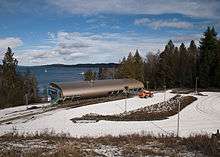Deep Bay Marine Field Station
The Deep Bay Marine Field Station is a marine biological research facility operated by Vancouver Island University's Centre for Shellfish Research. It is located at Deep Bay, British Columbia on Vancouver Island, off the waters of Baynes Sound, 78 kilometres (48 mi) north-west of the main university campus at Nanaimo, British Columbia.
 | |
| Formation | May 1, 2011 |
|---|---|
| Purpose | Shellfish Research |
| Location | |
| Coordinates | 49°27′21.31″N 124°44′06.15″W |
Parent organization | Centre for Shellfish Research, Vancouver Island University |
Facilities include a seawater tank farm, a laboratory, a demonstration shellfish farm and a combined research facility for shellfish aquaculture, marine ecology and water quality. The culinary program of VIU uses the kitchen facilities to prepare seafood and other dishes. The building received the first LEED platinum rating [1] among Canadian universities and a 2011 National Green Buildings Award. Located on a 3 hectares (7.4 acres) site, it is accessed by a road topped with crushed oyster shells. Beetle-killed pine flooring and other BC wood products were used in construction. It opened in 2011.[2]
Early priorities are research concerning geoduck clams and the possibility of restoring native Olympia oysters in the area.[3] The goal of the facility is "supporting sustainable shellfish aquaculture development and preserving coastal ecosystems."[4] Current research is creating a NextGen Shellfish Hatchery to helps supply local farmers with oyster seed.
NextGen Shellfish Hatchery
This exciting project has been funded by Western Economic Diversification Canada and has been ongoing since 2014. Changing environmental conditions in Baynes Sound have made Shellfish Hatcheries increasingly difficult to run. This project has brought in hatchery technologies from around the world in an attempt to see which technologies can be successfully used in British Columbia. Within this project we are:
- Using a continuous drip algal production system to produce algae for shellfish larvae. We are examining the energy usage from grow lights, the cost of nutrients, the amount of water used, and the amount of human resources time needed to raise a sufficient amount of algae. We're cataloging the reliability of the system and the growth densities that can be achieved.
- We're trialling different sizes, shapes and types of tanks for raising shellfish larvae.
- We're trialling a 'bottle upweller' system that has been successfully used in both Britain and Australia for growing high densities of oyster seed.
- We're using different techniques for controlling the pH, dissolved gas, and other water parameters important to shellfish production.[5]
Additional research is being done on oyster broodstock conditioning. This long term initiative is being carried out in partnership between VIU and the BC Shellfish Growers Association. This project is an environmental adaption initiative to address changing water conditions in Baynes Sound and the Salish Sea in general. Ocean acidification has made it more difficult for shellfish larvae to form a shell. This has impacted wild stocks and has impacted shellfish hatcheries ability to spawn and grow shellfish. This project is a selective breeding initiative designed to promote shellfish lines that are naturally resistant to changing environmental conditions while still maintaining a sufficiently diverse genetic base. We hope to develop a pool of brood stock for industry that performs well in Baynes Sound and the Salish Sea.[6]
References
- "2011 SAB Award Winning Project - VIU Deep Bay Marine Field Station". Sustainable Architecture and Building Magazine. 11 August 2011. Archived from the original on 2013-12-09. Retrieved 2012-04-28.
- Stanfield, Scott (23 June 2011). "Aquaculture research station opens at Deep Bay". Comox Valley Record. Comox. Archived from the original on 2011-06-29. Retrieved 2012-04-28.
- Barron, Robert (11 July 2011). "New $8.6-million facility an extension of VIU's Centre for Shellfish Research". The Daily News. Nanaimo. Archived from the original on 2013-01-19. Retrieved 2012-04-28.
- Busheikin, Laura (August 2011). "Studying the Depths: New marine field station aims to support sustainable aquaculture and preserve coastal ecosystems". In Focus Magazine. Retrieved 2012-04-28.
- "NextGen Shellfish Hatchery".
- "Brood Stock Conditioning Program | Deep Bay Marine Field Station | Vancouver Island University". research.viu.ca. Retrieved 2017-09-18.
External links
| Wikimedia Commons has media related to Deep Bay Marine Field Station. |
- Centre for Shellfish Research Official website
- The Deep Bay Marine Field Station
- Vancouver Island University